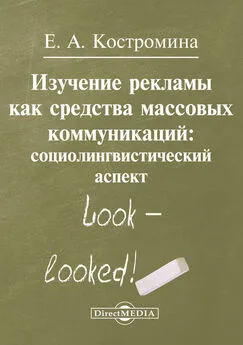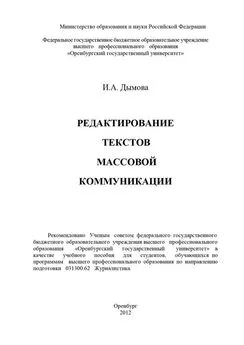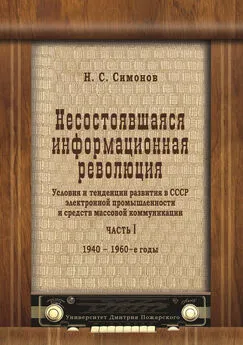Ричард Харрис - Психология массовых коммуникаций
- Название:Психология массовых коммуникаций
- Автор:
- Жанр:
- Издательство:2002
- Год:2002
- Город:Санкт-Петербург
- ISBN:5-93878-033-0
- Рейтинг:
- Избранное:Добавить в избранное
-
Отзывы:
-
Ваша оценка:
Ричард Харрис - Психология массовых коммуникаций краткое содержание
«Предупреждён – значит вооружён». Такой эпиграф мог бы открывать эту книгу. И не имеет значения, кто возьмёт её в руки. Специалист почерпнёт в ней новые приёмы и подходы к анализу стратегии и тактики СМИ. Любознательный обыватель научится обеспечивать собственную информационную безопасность.
Кроме того картина информационного ландшафта современного общества от предвыборного управления массовым сознанием до рекламы памперсов оказывается настолько захватывающей, что однажды начав читать эту книгу, вы уже не оставите её недочитанной.
Психология массовых коммуникаций - читать онлайн бесплатно полную версию (весь текст целиком)
Интервал:
Закладка:
Marginalia. (1998, May 22). The Chronicle of Higher Education. 44 (37). p. A8.
Marquez de Melo, J. (1991. May). The presence of the Brazilian telenovelas in the internationalmarket: Case study of Globo network. Paper presented at meeting of the International Communication Association, Chicago, IL.
Martz, L. (1998, May). Defending the most basic freedom. World Press Review, p. 14–16.
Massing, H. H. (1987). Decoding "Dallas": Comparing American and German viewers. In: A. A. Berger (Ed.). Television in sociery (p. 96–103). New Brunswick, NJ: Transaction Books.
Masterman, L. (1985). Teaching the media. London: Comedia.
Matabane, P. W. (1988). Television and the black audience: Cultivating moderate perspectives on racial integration. Journal of Communication, 38(4), 21–31.
Matas, M., Guebaly, N , Harper, D., Green, M., Peterkin, A. (1986). Mental illness and the media: Part II. Content analysis of press coverage of mental health topics. Canadian Journal of Psychiatry, 31, 431–433.
Mattussek, M. (1995, April 3). Tuning in hate. Der Spiegel. (Reprinted in: World Press Review, June 1995, p. 26–27.)
McAlistcr, A. L., Puska, P., Salonen, J. T. (1982). Theory and action for health promotion: Illustrations from the North Karelia project. American Journal of Public Health, 72. 43–50.
McAnany, E. G. (1983). Television and crisis: Ten years of network news coverage of Central America, 1972–1981. Media, culture and society, 5(2), 199–212.
McCaulcy, C.. Thangavelu, K., Rozin. P. (1988). Sex stereotyping of occupations in relation to television representations and census facts. Basic and Applied Social Psychology, 9197–212.
McChesney, R. W. (1989). Media made sport: A history of sports coverage in the United States. In: L. A. Wenner (Ed.). Medici, sports, and society (p. 46–69). New-bury Park, CA: Sage.
McCombs, M. E. (1981). The agenda-setting approach. In: D. D. Nimmo K. R. Sanders (Eds.). Handbook ofpolitical communication (p. 121–140). Beverly Hills, CA: Sage.
McCombs, M. E. (1994). News influence on our pictures of the world. In: J. Bryant and D. Zillmann (Eds.). Media effects: Advances in theory and research (p. 1–16). Hillsdate, NJ: Lawrence Eribaum Associates.
McCombs. M. E., Gilbert, S. (1986). News influence on our pictures of the world. In: J. Bryant D. Zillmann (Eds.). Perspectives on media effects (p. 1–15). Hillsdale. NJ: Lawrence Eribaum Associates.
McCombs, M. E., Shaw, D. L. (1993). The evolution of agenda-setting research: Twenty-five years in the marketplace of ideas. Journal of Communication, 43(2), 58–67.
McCombs, M. E., Shaw, D. L., Weaver, D. (Eds.). (1997). Communication and democracy: Exploring the intellectual/rentiers in agenda-setting theory. Mahwah, NJ: Lawrence Eribaum Associates.
McDermott, S., Greenberg. B. (1985). Parents, peers, and television as determinants of black children's esteem. In: R. Bostrom (Ed.). Communication yearbook 8. Beverly Hills, CA: Sage.
McGhee, P. (1979). Humor: Its origin and development. San Francisco: Freeman.
McGuire, W. J. (1974). Psychological motives and communication gratification. In: J. G. Blumler E. Katz (Eds.). The uses of mass communications: Current perspectives on gratifications research (p. 167–196). Beverly Hills, CA: Sage.
McGuire, W. J. (1985 a). Attitudes and attitude change. In: G. Lindzey E. Aronson (Eds.). Handbook of social psychology (3rd ed.). Reading, MA: Addison-Wesley.
McGuire, W. J. (1985 b). The myth of massive media impact: Savagings and salvagings. In: G. Comstock (Ed.). Public communication and behavior (Vol. I). New York: Academic Press.
McJntyre, P., Hosch, H. M., Harris, R. J., Norvell, D. W. (1986). Effects of sex and attitudes toward women on the processing of television commercials. Psychology and Marketing. 3, 181–190.
McKenzie-Mohr, D., Zanna, M. R (1990). Treating women as sexual objects: Look to the (gender schematic) male who has viewed pornography. Personality and Social Psychology Bulletin, 16, 296–308.
McNeal, J. U. (1987). Children as consumers: Insights and implications. Lexington MA: Lexington Books. McNeal, J. U. (1990). From savers to spenders: How children became a consumer market. Media Values 52, 4–6.
Meadowcroft, J. M., Reeves, B. (1989). Influence of story schema development on children's attention to television. Communication Research, 16, 352–374.
Melton, G., Fowler, G. (I987). Female roles in radio advertising. Journalism Quarterly, 64(l), I45–I49.
Mendelsohn, H. A. (1966). Election-day broadcasts and terminal voting decisions. Public Opinion Quarterly, 30, 212–225.
Mendelsohn, H. A., O'Keefe, G. J. (1976). The people choose a President: Influences on voter decision making. New York: Praeger.
Merikle, P. M. (I988). Subliminal auditory messages: An evaluation. Psychology Marketing, 5, 355–372.
Merikle, P. M., Cheesman, J. (I987). Current status of research on subliminal advertising. Advances in Consumer Research, 14 298–302.
Merikle, P. M., Skanes, H. E. (1992). Subliminal self-help audiotapes: A search for placebo effects. Journal of Applied Psychology, 77, 772–776.
Meringoff. L. K. (1980). Influence of the medium on children's story apprehension. Journal of Educational Psychology. 72, 240–249.
Meringoff. L. K., Vibbert, M. M., Char, C. A., Fernie, D. E., Banker. G. S., Gardner, H. (1983). In: J. Bryant D. R. Anderson (Eds.). Children's understanding of television (p. 151–179). New York: Academic Press.
Merritt. S. (1984). Negative political advertising: Some empirical findings. Journal of Advertising. 13. 27–38.
Mesmer, T. Baskind, I., Lerdau. E. (1998, October). Reflecting on an alliance. /4mericas, 50(5), 52–55.
Messaris, R (1994). Visual "literacy": Image, mind, and reality. Boulder. CO: Westview Press.
Messaris. R (I997). Visual persuasion: The role of images in advertising. Thousand Oaks, CA: Sage.
Messaris, P. (1998). Visual aspects of media literacy. Journal of Communication, 4!?(I), 70–80.
Messner, M. A., Duncan, M. C., Jensen, K. (1993). Separating the men from the girls: The gendered language of televised sports. Gender Society, 7, 121–137.
Meyer. P. (1990). News media responsive ness to public health. In: C. Atkin L. Wallack (Eds.). Mass communication and public health: Complexities and conflicts (p. 52–57). Newbury Park, CA: Sage.
Meyrowitz, J. (1985). No sense of plate: The impact of electronic media on social behavior. New York: Oxford University Press.
Meyrowitz. J. (1998). Multiple media literacies. Journal of Communication, 48(1). 96–108.
Mieike, K. W., Chen, M. (1983). Formative research for 3–2–1 Contact: Methods and insights. In: M. J. A. Howe (Ed.). Learning from television: Psychological and educational research (p. 31–55). London: Academic Press.
Milavsky, J. R., Kessler. R., Stipp, H., Rubens, W. (1982). Television and aggression: Results of a panel study. In: D. Pearl, L. Bouthilet, J. Lazar (Eds.). Television and behavior: Ten yean of scientific progress and implications for the eighties (Vol. 2, p. 138–157). Washington, DC: U. S. Government Printing Office.
Moisy. C. (1997, Summer). Myths of the global information village. Foreign Policy, p. 78–87.
Moore, D. L., Hausknecht, D., Thamodaran, K. (1986). Time compression, response opportunity, and persuasion. Journal of Consumer Research, 13, 85–99.
Moore, Т . Е . (1982). What you see is what you get. Journal of Marketing, 46(2), 38–47.
Moore, T. E. (1988). The case against subliminal manipulation. Psychology Marketing, 5, 297–316.
Morgan, M. (1982). Television and adolescents' sex-role stereotypes: A longitudinal study. Journal of Personality and Social Psychology, 43(5), 947–955.
Morgan, M. (1989). Television and democracy. In: I. Angus S. Jhally (Eds.). Cultural politics in contemporary America (p. 240–253). New York: Routledgc.
Morgan, M. (1990). International cultivation analysis. In: N. Signorielli M. Morgan (Eds.). Cultivation analysis: New directions in media effects research (p. 225–247). Newbury Park, CA: Sage.
Morgan, M., Gerbner, G. (1982). TV professions and adolescent career choices. In: M. Schwarz (Ed.). TV and teens: Experts look at the issues (p. 121–126). Reading, MA: Addison-Wesley.
Morgan, M., Shanahan, J. (1991). Television and the cultivation of political attitudes in Argentina. Journal of Communication, 41(1). 88–103.
Morgan, M., Shanahan, J. (1992). Comparative cultivation analysis: Television and adolescents in Argentina and Taiwan. In: F. Korzenny S. Ting-Toomey (Eds.). Mass media effects across cultures (p. 173–197). Newbury Park. CA: Sage.
Morgan, M., Shanahan, J. (1995). Democracy tango: Television, adolescents, and authoritarian tensions in Argentina. Cresskill, NJ: Hampton Press.
Morgan, M., Signorielli, N. (1990). Cultivation analysis: Conceptualization and methodology. In: N. Signorielh M. Morgan (Eds.). Cultivation analysis: New directions in media effects research (p. 13–34). Newbury Park, CA: Sage.
Moritz, M. J. (1995). The gay agenda: Marketing hate speech to the mainstream media. In: R. K. Whillock D. Slayden (Eds.). Hate speech (p. 55–79). Thousand Oaks. CA: Sage.
Morley, D. (1988). Domestic relations: The framework of family viewing in Great Britain. In: J. Lull (Ed.). World families watch television (p. 22–48). Newbury Park, CA: Sage.
Morris, J. S. (1982). Television portrayal and the socialization of the American Indian child. In: G. L. Berry C. Mitchell-Kernan (Eds.). Television and the socialization of the minority child (p. 187–202). New York: Academic Press.
Morris, M., Ogan. C. (1996). The Internet as mass medium. Journal of Communication, 46(1), 39–50. Most Famous Canadian. (1996, February) World Press Review, p. 33.
Mowlana, H. (1984). The role of the media in the U. S.-Iranian conflict. In: A. Arno W. Dissayanake (Eds.). The news media in national and international conflict (p. 71–99). Boulder, CO: Westview Press.
Mowlana, H., Gerbner, G., Schiller, H. (Eds.). (1993). Triumph of the image: The media's war in the Persian Gulf–A global perspective. Boulder, CO: West-view Press.
Mundorf. N.. Drew, D., Zillmann, D., Weaver, J. (1990). Effects of disturbing news on recall of subsequently presented news. Communication Research, 17, 601–615.
Mundorf, N., Weaver, J., Zillmann, D. (1989). Effects of gender roles and self-perceptions on affective reactions to horror films. Sex Roles, 20, 655–673.
Mutz, D. C., Roberts. D. F, van Vuuren, D. P. (1993). Reconsidering the displacement hypothesis. M Communication Research, 20, 51–75.
Myers, D. G. (1992). Psychology (3rd ed.). New York: Worth Publishers.
Myers, P. N., Jr., Biocca, F. A. (1992). The elastic body image: The effect of television advertising and programming on body image distortions in young women. Journal of Communication, 42(3), 108–133. National Television Violence Study (Vols. 1–2.). (1997). Thousand Oaks, CA: Sage.
Naughton, J. (1998, January 9). Colleges eye restrictions on promotions by brewing companies. The Chronicle of Higher Education, p. A57.
Nelson, J. P., Gelfand, D. M., Hartmann, D. R (1969). Children's aggression following competition and exposure to an aggressive model. Child Development, 40, 1085–1097.
Newhagen, J. E., Reeves, B. (1991). Emotion and memory responses for negative political advertising: A study of television commercials used in the 1988 Presidential election. In: F. Biocca (Ed.). Television and political advertising. Vol. J: Psychological processes (p. 197–220). Hillsdale, NJ: Lawrence Eribaum Associates.
Newhagen, J. E., Reeves, B. (1992). The evening's bad news: Effects of compelling negative television news images on memory. Journal of Communication, 42(2), 25–41.
Читать дальшеИнтервал:
Закладка:










